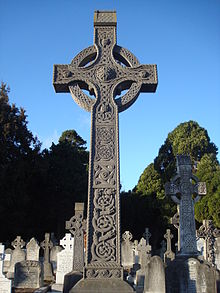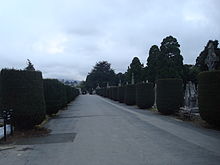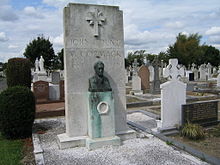- Deans Grange Cemetery
-
Deans Grange Cemetery, or more commonly known today as Deansgrange Cemetery, is situated in the suburban area of Deansgrange in the Dun Laoghaire-Rathdown part of the former County Dublin, Ireland. Since it first opened in 1865, over 150,000 people have been buried there. It is, together with Glasnevin and Mount Jerome, one of the largest cemeteries in the Dublin area occupying 70 acres (280,000 m2).
Contents
History
The Burial Act of 1855 resulted in the closure of many of the older churchyards in Dublin and surrounds due to overcrowding. This drove the need to find new lands for cemeteries.[1]
The initial cemetery consisted of just 8 acres (32,000 m2) bought by the Rathdown Union from Rev. John Beatty. The price agreed was £200 which Rev. Beaty set as being equivalent to twenty years rent. A committee was formed to run the new cemetery and on 20 November 1861 Sir George Hobson, chairman of the Guardians of the Rural Districts of the Union, signed the deeds establishing the new cemetery. The new committee set about appointing Matthew Betham as the chairman and Joseph Cope as the office clerk of admin duties and building the new cemetery.[2]
The cemetery was laid out with just 2 sections, North for Catholic and South for Protestant religions as well as separate chapels for both. It also consisted of a Gate Lodge (Registrar's house) and yew trees lining the main walkways. The buildings were constructed by Matthew Gahan, whose name can be seen on the metal doors to the vaults under each chapel.[2]
It was 1865 when the cemetery took its first burial on 28 January 1865 of Anastasia Carey, buried near the Catholic chapel. There were four grave types to be chosen by the families.[2]
- 1st Class located adjacent to the main pathways and considered the most prominent and most expensive.
- 2nd Class located adjacent to the smaller pathways and expensive.
- 3rd Class surrounded by other plots where payment was required within five years. Failure to pay resulted in the grave reverting to the Burial Board for reuse.
- 4th Class on loan and reverted to the Burial board for reuse after a number of years.
Since the opening of the cemetery 2 sections were added, South West and West, and the North section was extended. From the 1930s more land was bought and new sections were created and named after different saints bringing the total number of sections to 16.[2]
In 1984 a sister cemetery was opened south of Shankill village called Shanganagh Cemetery and occupying 50 acres (200,000 m2). By the late 1980s the cemetery was running out of space and it was decided to stop selling new grave spaces. However, recent proposals around 2008 will see a small number of improvements and spaces made available.[2]
The gate lodge was lived in by the registrar until the late 1990s when it was vacated.[2]
Today Dean's Grange Cemetery is administered by Dún Laoghaire-Rathdown County Council.
Notable Burials
John Count McCormack (1884–1945), world-famous tenor
Interred in the cemetery are people from notable events in local and Irish history.
- The 15 local men of the Kingstown Lifeboat Disaster in 1895 who crewed a rescue boat involved in an attempt to rescue the Palme.[1]
- The Angels plot used from 1905 to 1989 to bury children. It is reckoned that 750 children are buried here. Cemetery staff renovated the plot around 2008.[3]
- During the 1916 rising, the cemetery saw the burial of about 50 people connected to the rising. They were either innocent victims, republican volunteers or British soldiers. There is a plot with 6 people buried and the rest are buried by their respective families.[3]
- RMS Leinster was torpedoed by a German submarine 12 miles (19 km) from Dún Laoghaire in 1918. Eleven known victims are buried in the cemetery.[3]
Also interred at Deans Grange:
- Todd Andrews (1901–1985), government minister
- Alan Bell (1858–1920), magistrate and member of the British Secret Service, executed by the IRA during the Irish War of Independence.[3]
- Richard Irvine Best (1872–1959), Celtic scholar[1]
- Richard Sinclair Brooke (1802–1882), first incumbent of the Mariners' Church, Dún Laoghaire and his wife Anna Stopford (1812–1903)
- Francis Browning (1868–1916), cricketer and President of the Irish Rugby Football Union
- Anastasia Carey (1824–1865), the first interment in Dean's Grange Cemetery, worked for the nuns of St. Joseph's Orphanage, died of typhus fever[3]
- John A. Costello (1891–1976), Taoiseach and Fine Gael politician.[3]
- Moya Llewelyn Davies, Irish republican, who lost her family through food poisoning as a child and translated Fiche Bliain ag Fás (Twenty Years a'Growing) by Muiris Ó Súilleabháin[4]
- Constantine Curran (1880–1972), writer[1]
- Rickard Deasy (1812–1883), lawyer and Member of Parliament for Cork County
- John Boyd Dunlop (1840–1921), inventor
- Reginald Dunne (died 1922), Irish republican (with Joseph O'Sullivan, executed for the killing of Sir Henry Wilson)
- Frank Fahy (1880–1953), Teachta Dála (TD) and Ceann Comhairle (speaker)
- Michael Farrell (1899–1962), writer[1]
- Barry Fitzgerald (1888–1961), actor[1]
- Augustine Henry (1857–1930), botanist[1]
- Seán Lemass (1899–1971), Taoiseach and Fianna Fáil politician[3]
- Kathleen Lynn (1874–1955), suffragette, member of the Irish Citizen Army and TD for the Dublin County constituency
- Donagh MacDonagh (1912–1968), writer and judge[1]
- John Count McCormack (1884–1945), world-famous tenor[1]
- F. J. McCormick (1889–1947), actor[1]
- Joseph McGrath (1887–1966), politician and a founder of the Irish Hospitals' Sweepstake[1]
- Anew McMaster (1894–1962), actor[1]
- Dermot Morgan (1952–1998), comedian and actor[3]
- Brian O'Nolan (literary name Flann O'Brien) (1911–1966), novelist[1]
- John Gardiner Nutting (1852–1918), baronet of St Helen's, Booterstown[1]
- Frank O'Connor (1903–1966), writer[1]
- Pádraig Ó Siochfhradha (1883–1964), writer and teacher of the Irish language[1]
- Joseph O'Sullivan (died 1922), Irish republican
- John Howard Parnell (1846–1923), politician and older brother to Charles Stewart Parnell[1]
- Noel Purcell (1900–1985), actor[1]
- John Talbot Power, 3rd Baronet of Edermine (1845–1901), lived in Leopardstown Park and grandson of the founder of Power's Distillery, Dublin[1]
- James Vaughan (died 1873), Captain in the Royal Navy[1]
- Ernest Walton (1903–1995), physicist and Nobel Laureate
- Joseph Edward Woodall (1896–1962), winner of the Victoria Cross[1][5]
There are many Religious Orders buried here such as the Congregation of Christian Brothers, Daughters of the Cross, Holy Ghost Fathers, Irish Vincentians, the Little Sisters of the Assumption and the Missionaries of the Sacred Heart.[1]
References
- ^ a b c d e f g h i j k l m n o p q r s t u v Igoe, Vivien (2001). "Dublin Burial Grounds & Graveyards", Wolfhound Press, p76, ISBN 0863278728
- ^ a b c d e f Moran, Jamie (2009). "Dean's Grange Cemetery: Stories from beyond the grave", Chuil Aoibhinn Publications, p11-25 Overview, ISBN 9780956172907
- ^ a b c d e f g h Moran, Jamie (2009). "Dean's Grange Cemetery: Stories from beyond the grave", Chuil Aoibhinn Publications, p26-204 Notable, ISBN 9780956172907
- ^ Biography
- ^ Location of grave
External links
Categories:- Burials at Deans Grange Cemetery
- Cemeteries in the Republic of Ireland
Wikimedia Foundation. 2010.



